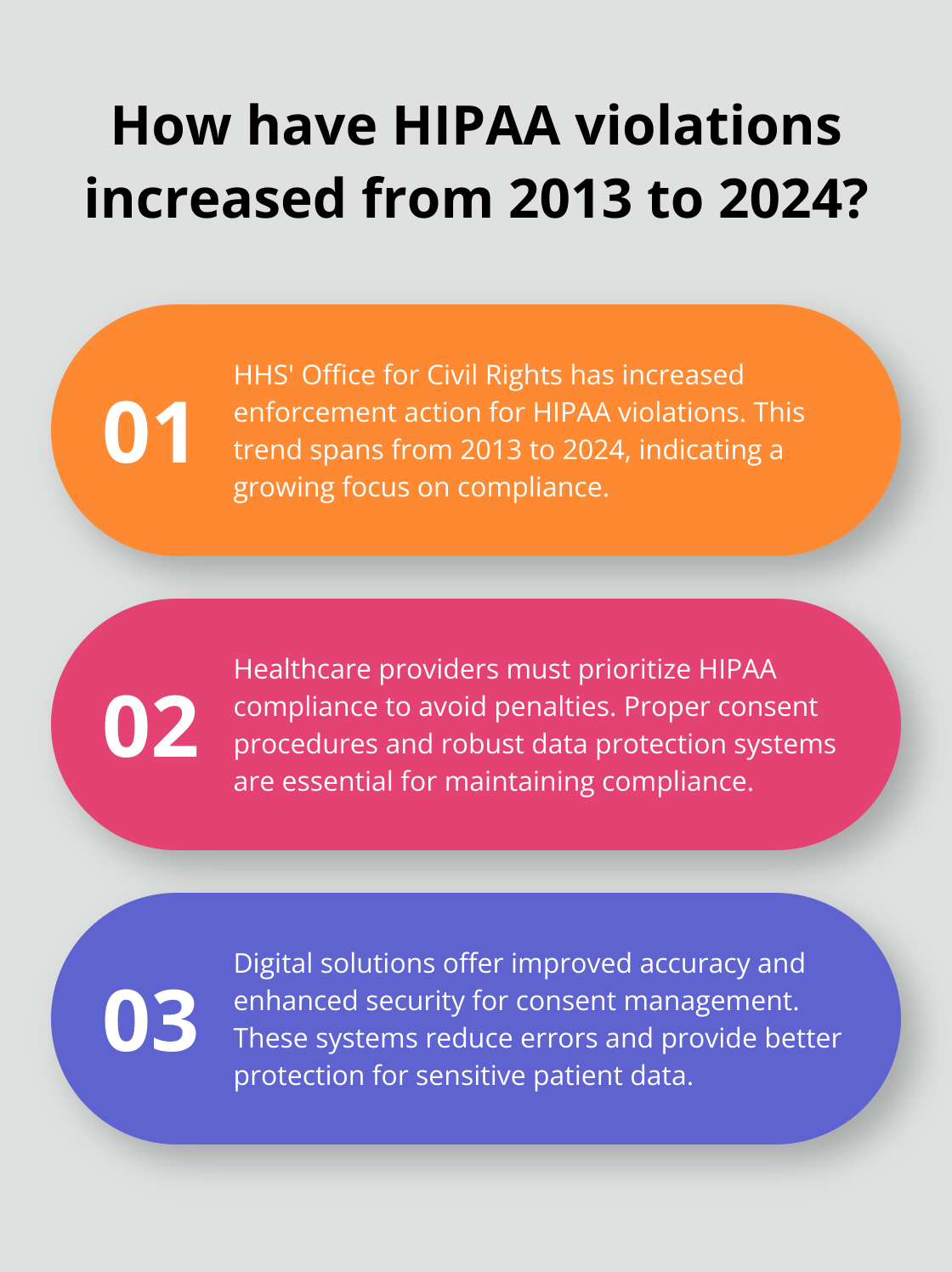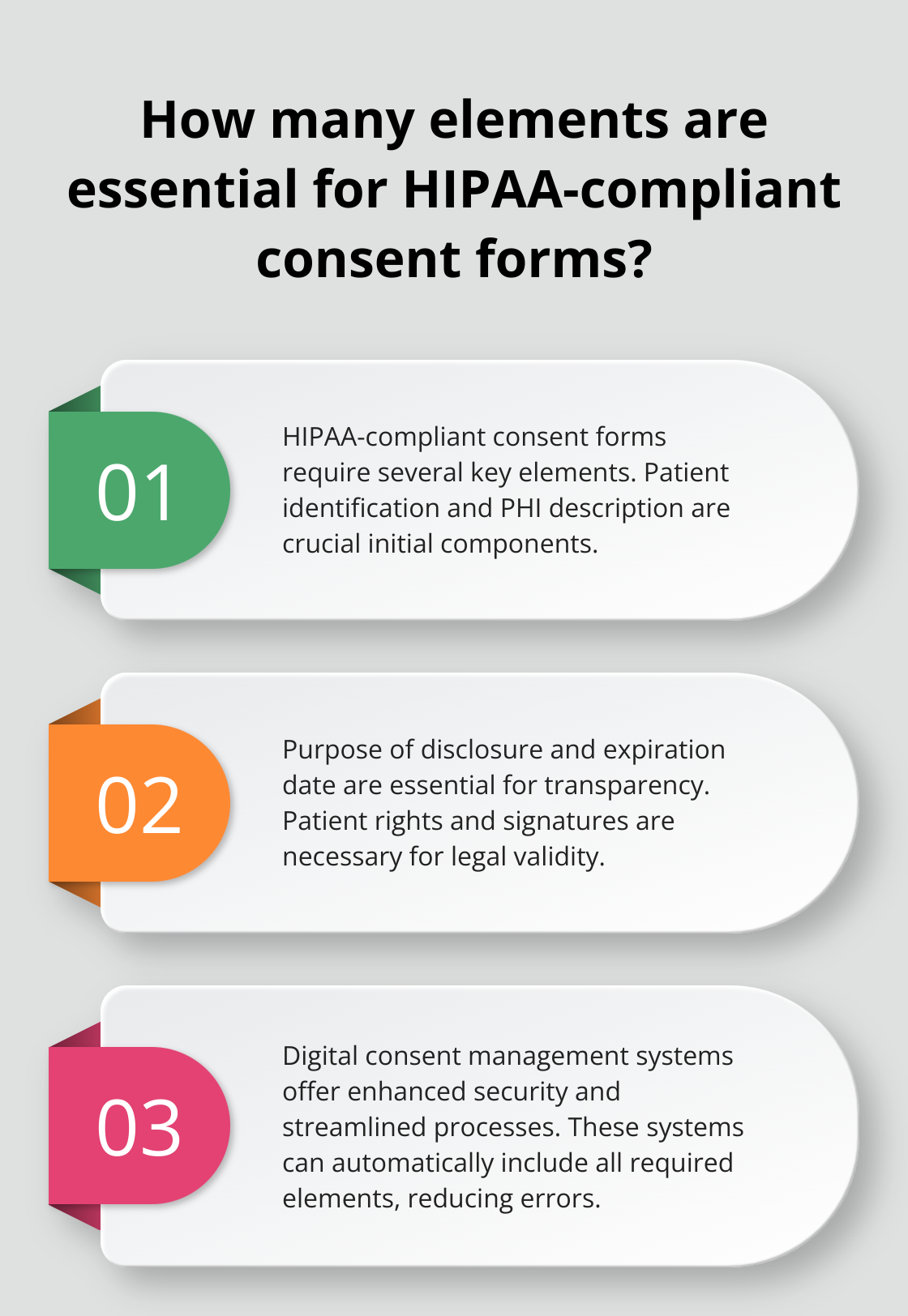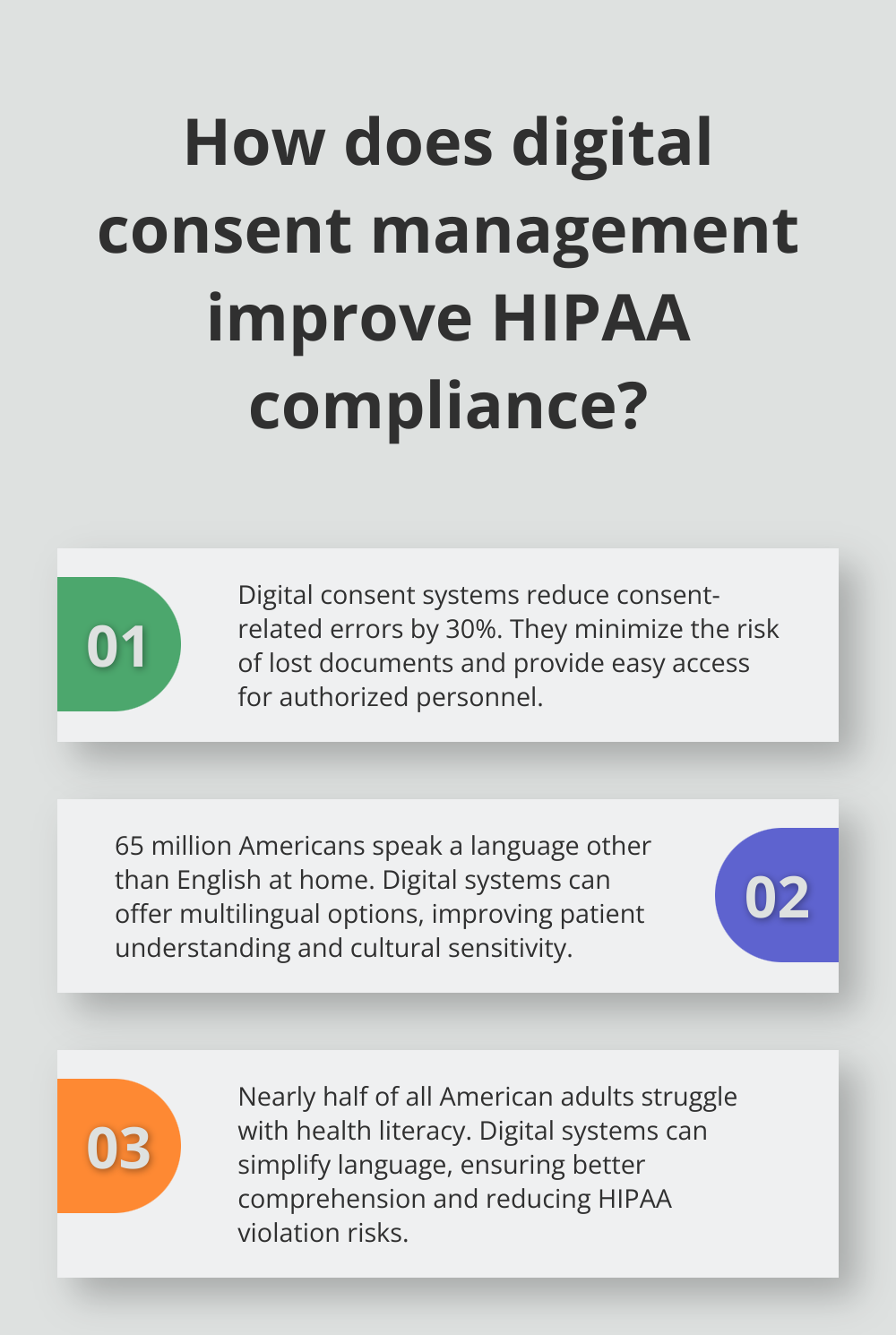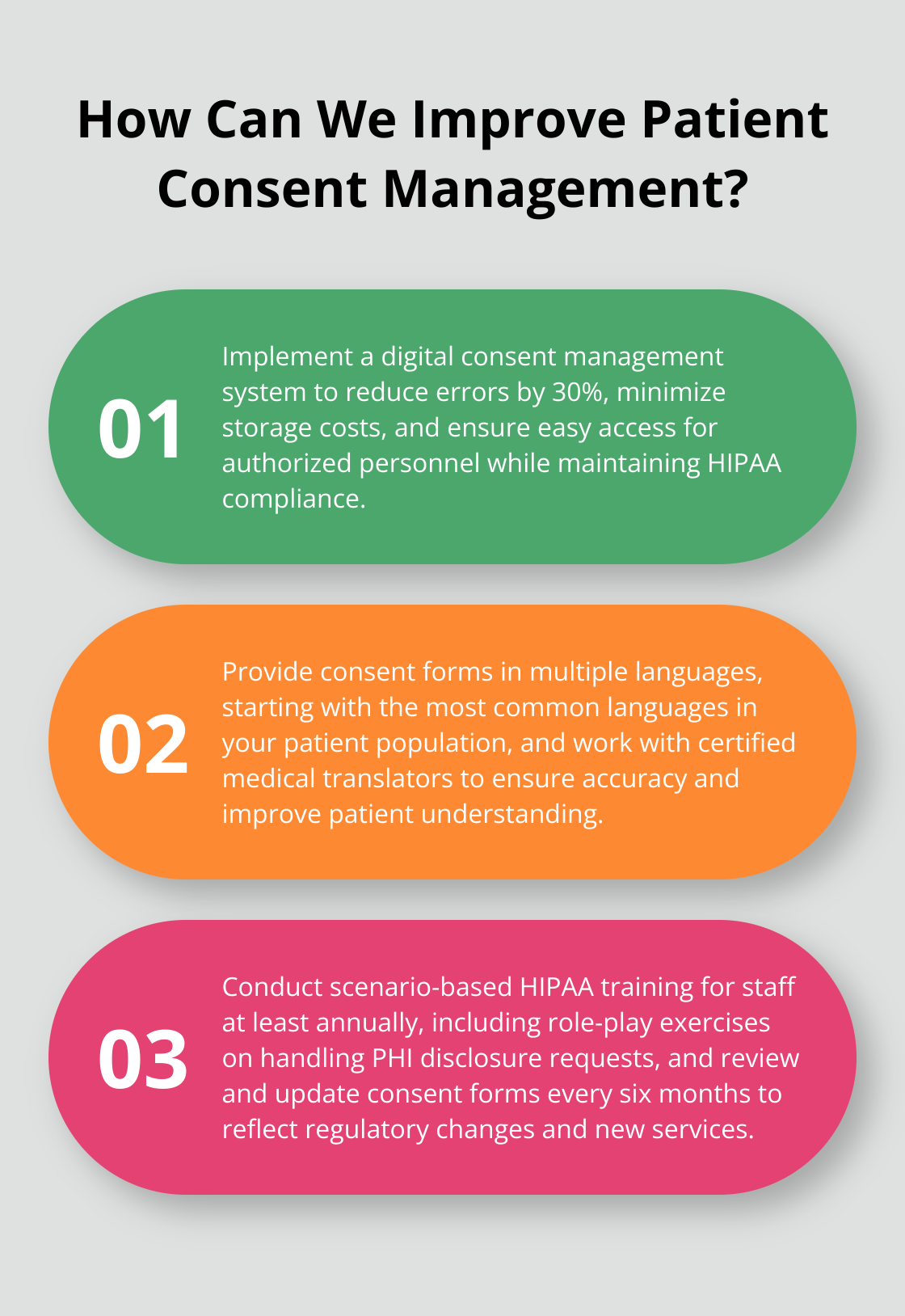Patient consent forms are a cornerstone of HIPAA compliance in healthcare. These documents protect patient privacy and ensure informed decision-making about the use and disclosure of personal health information.
At ScriberJoy, we understand the critical role that HIPAA-compliant patient consent forms play in maintaining trust between healthcare providers and their patients. This blog post will guide you through the essential elements and best practices for implementing these vital documents in your practice.
What Are HIPAA-Compliant Patient Consent Forms?
Definition and Purpose
HIPAA-compliant patient consent forms are legal documents healthcare providers use to obtain permission from patients to use or disclose their protected health information (PHI). These forms protect patient privacy, facilitate informed decision-making, and create a legal record of the patient’s agreement to share their information.
Key Components of HIPAA Compliance
HIPAA compliance extends beyond patient signatures on forms. It requires a comprehensive system to protect patient data, including:
- Data encryption: All electronic PHI must be encrypted in transit and at rest.
- Access controls: Only authorized personnel should access PHI.
- Audit trails: All PHI access must be logged and monitored.
- Employee training: Staff must receive regular training on HIPAA regulations.

A summary of HIPAA violation cases from 2013 to 2024 indicates that HHS’ Office for Civil Rights is increasing enforcement action, highlighting the need for healthcare providers to prioritize compliance.
Impact on Healthcare Outcomes
Proper consent procedures significantly influence healthcare outcomes. Patients who fully understand their consent forms are more likely to adhere to their treatment plans.
Moreover, healthcare providers who implement robust consent procedures face fewer legal challenges. Practices with comprehensive consent processes experience fewer malpractice claims related to privacy breaches.
Digital Solutions for Consent Management
Modern healthcare practices increasingly turn to digital solutions for consent management. These systems (like ScriberJoy) offer several advantages:
- Improved accuracy: Digital forms reduce errors associated with handwritten information.
- Enhanced security: Electronic storage provides better protection for sensitive data.
- Streamlined processes: Digital consent forms integrate seamlessly with electronic medical records.
- Increased efficiency: Staff spend less time on paperwork and more time on patient care.
As we move forward, we’ll explore the essential elements that make up a HIPAA-compliant consent form, ensuring you have all the information needed to protect your patients’ privacy and your practice’s integrity.
Essential Elements of HIPAA-Compliant Consent Forms
HIPAA-compliant consent forms serve as critical documents that protect patient privacy and ensure informed decision-making. Healthcare providers must include several key elements to create an effective consent form. This chapter explores these essential components in detail.
Patient Identification and PHI Description
Every HIPAA-compliant consent form must start with accurate patient identification. This includes the patient’s full name, date of birth, and contact information. Specificity and thoroughness are paramount to avoid any confusion or potential mix-ups.

The form must clearly describe the protected health information (PHI) that will be used or disclosed. This description should provide enough detail for patients to understand exactly what information they allow to be shared. For example, instead of a vague statement like “medical records,” specify “laboratory results from January 1, 2025, to March 1, 2025.”
Purpose and Expiration
The purpose of the use or disclosure must be explicitly stated. Patients need to know why their information is being shared and with whom. This transparency builds trust and ensures patients are fully informed about how their data will be used.
An often overlooked but essential element is the expiration date or event. This defines when the authorization will no longer be valid. It could be a specific date (e.g., “December 31, 2025”) or an event (e.g., “upon completion of the research study”).
Patient Rights and Signature
Patients must be informed of their right to revoke consent. The form should explain how they can revoke their authorization and any limitations on this right. For instance, if the information has already been disclosed based on the authorization, it cannot be “undisclosed.”
The patient’s signature and the date of signing are essential. Without these, the form is not legally valid.
Digital Consent Management
With the rise of digital health records, many healthcare providers now turn to electronic consent forms. These digital solutions (like ScriberJoy) offer enhanced security features and streamline the consent process. They can automatically include all required elements, reducing the risk of omissions or errors.
Digital consent management systems also make it easier to track and update consents. They offer features such as access controls and audit trails to ensure compliance with HIPAA regulations.
Healthcare providers who ensure all these elements are present and clearly explained create HIPAA-compliant consent forms that protect both patient privacy and the integrity of their practice. The next chapter will explore best practices for implementing these forms effectively in your healthcare setting.
How to Implement HIPAA-Compliant Consent Forms
Simplify Your Language
Complex medical jargon often confuses patients. Nearly half of all American adults – 90 million people – have difficulty understanding and using health information. Use plain language that a person with an eighth-grade reading level can understand. Replace “myocardial infarction” with “heart attack.” This approach ensures better comprehension and reduces the risk of misunderstandings that could lead to HIPAA violations.
Offer Multilingual Options
The U.S. Census Bureau reports that over 65 million Americans speak a language other than English at home. Provide consent forms in multiple languages to accommodate this diversity. Start with the most common languages in your patient population. If you serve a large Spanish-speaking community, prioritize Spanish translations. Work with certified medical translators to ensure accuracy. This step improves patient understanding and demonstrates cultural sensitivity.
Use Digital Consent Management
Paper-based consent forms are outdated. Digital consent management systems offer numerous advantages. They reduce storage costs, minimize the risk of lost documents, and provide easy access for authorized personnel. A report by KLAS Research shows that healthcare providers using digital consent systems saw a 30% reduction in consent-related errors. Choose a digital system with robust security features (such as encryption and access controls). ScriberJoy offers a secure platform that integrates seamlessly with existing electronic medical records, ensuring HIPAA compliance while streamlining the consent process.
Train Your Staff
Your staff plays a key role in maintaining HIPAA compliance. The Office for Civil Rights recommends annual HIPAA training at a minimum. Consider more frequent sessions, especially when regulations change. Create scenario-based training modules that reflect real-world situations your staff might encounter. Role-play exercises on how to handle requests for PHI disclosure can be particularly effective. Monitor staff performance and provide additional support where needed.
Review and Update Regularly
HIPAA regulations evolve, and so should your consent forms. Set a schedule for regular reviews, ideally every six months. During these reviews, check for any changes in HIPAA regulations, updates in your organization’s policies, or feedback from patients and staff. If you’ve introduced new services or technologies, your consent forms may need to reflect these changes. Keep a log of all updates and inform all staff of changes promptly.

Final Thoughts
HIPAA-compliant patient consent forms establish trust between healthcare providers and patients. These forms protect patient privacy, support informed decisions, and shield healthcare organizations from legal risks. Healthcare providers who implement robust consent processes demonstrate their commitment to patient rights and data protection.

Proper consent management reduces the risk of HIPAA violations and improves patient satisfaction. Patients feel more in control of their health information, which leads to better health outcomes and stronger patient-provider relationships. Healthcare providers should regularly review and improve their consent processes to stay current with HIPAA regulations.
We at ScriberJoy offer medical transcription software that adheres to strict HIPAA standards. Our solution helps streamline documentation processes while maintaining patient privacy and data security. Healthcare providers who prioritize HIPAA compliance in patient consent forms respect patient rights and provide the best possible care.

Leave a Reply
You must be logged in to post a comment.